I'm working with the base64 module for image manipulation.
I've got this code:
import flask, base64, webbrowser, PIL.Image
...
...
image = PIL.Image.frombytes(mode='RGBA', size=(cam_width, cam_height), data=file_to_upload)
im_base64 = base64.b64encode(image.tobytes())
html = '<html><head><meta http-equiv="refresh" content="0.5"><title>Displaying Uploaded Image</title></head><body><h1>Displaying Uploaded Image</h1><img src="data:;base64,{}" alt="" /></body></html>'.format(im_base64.decode('utf8'))
html_url = '/home/mark/Desktop/FlaskUpload/test.html'
with open(html_url, 'w') as f:
f.write(html)
webbrowser.open(html_url)
I've also tried:
html = '<html><head><meta http-equiv="refresh" content="0.5"><title>Displaying Uploaded Image</title></head><body><h1>Displaying Uploaded Image</h1><img src="data:;base64,"'+im_base64.decode('utf8')+'" alt="" /></body></html>'
The heading is being rendered just fine but not the image. Have I missed anything ?
Update:
cam_width is 720
cam_height is 1280
file_to_upload is 3686400
first 10 bytes of the file_to_upload:
b'YPO\xffYPO\xffVQ'
I can't seem to get first 10 bytes of im_base64 with print(image.tobytes()[:10]) as it throws an error.
I got little bit closer to determining what's wrong. Once I fixed the quotes I got error:
Traceback (most recent call last):
File "/home/mark/venv/lib/python3.7/site-packages/flask/app.py", line 2464, in __call__
return self.wsgi_app(environ, start_response)
File "/home/mark/venv/lib/python3.7/site-packages/flask/app.py", line 2450, in wsgi_app
response = self.handle_exception(e)
File "/home/mark/venv/lib/python3.7/site-packages/flask/app.py", line 1867, in handle_exception
reraise(exc_type, exc_value, tb)
File "/home/mark/venv/lib/python3.7/site-packages/flask/_compat.py", line 39, in reraise
raise value
File "/home/mark/venv/lib/python3.7/site-packages/flask/app.py", line 2447, in wsgi_app
response = self.full_dispatch_request()
File "/home/mark/venv/lib/python3.7/site-packages/flask/app.py", line 1952, in full_dispatch_request
rv = self.handle_user_exception(e)
File "/home/mark/venv/lib/python3.7/site-packages/flask/app.py", line 1821, in handle_user_exception
reraise(exc_type, exc_value, tb)
File "/home/mark/venv/lib/python3.7/site-packages/flask/_compat.py", line 39, in reraise
raise value
File "/home/mark/venv/lib/python3.7/site-packages/flask/app.py", line 1950, in full_dispatch_request
rv = self.dispatch_request()
File "/home/mark/venv/lib/python3.7/site-packages/flask/app.py", line 1936, in dispatch_request
return self.view_functions[rule.endpoint](**req.view_args)
File "/home/mark/venv/server.py", line 28, in upload_file
image = PIL.Image.frombytes(mode='RGBA', size=(cam_width, cam_height), data=file_to_upload)
File "/home/mark/venv/lib/python3.7/site-packages/PIL/Image.py", line 2650, in frombytes
im.frombytes(data, decoder_name, args)
File "/home/mark/venv/lib/python3.7/site-packages/PIL/Image.py", line 797, in frombytes
d.setimage(self.im)
ValueError: tile cannot extend outside image
I'm working with image manipulation for the very first time so I don't know what I'm doing. What ValueError: tile cannot extend outside image means ?
